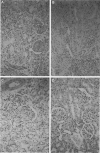Abstract
Complement is both an effector of the humoral immune response and a stimulator of leukocyte activation. To examine the influence of complement on the allograft response, we inhibited complement using recombinant human soluble complement receptor-1 (sCR1; TP10), in an unsensitized model of rat renal allograft rejection. Lewis to DA renal transplant recipients were treated daily with 25 mg/kg sCR1 or saline and sacrificed on days 1 to 5 after transplant. Transplanted organs were examined histologically and immunohistochemically for leukocyte subset markers and for the third component of complement, C3, and membrane attack complex deposition. A second set of recipients was followed from day 5 to day 9 to assess graft survival. sCR1-treated recipients displayed > 90% inhibition of plasma complement activity and a marked reduction in tissue C3 and membrane attack complex deposition. Inactivation of complement reduced the vascular injury such that there was almost complete sparing of vascular damage in day 5 sCR1-treated rats. There was a significant reduction in infiltrating leukocytes by day 5 after transplant, and complement inhibition delayed the time to reach a histologically defined end point of graft survival from 5 days in controls to 9 days in the sCR1-treated group. These results imply that the vascular and cell-mediated injury arises, in part, from complement activation. The partial inhibition of these injuries by sCR1 may have functional implications for strategies to inhibit allograft rejection.
Full text
PDF
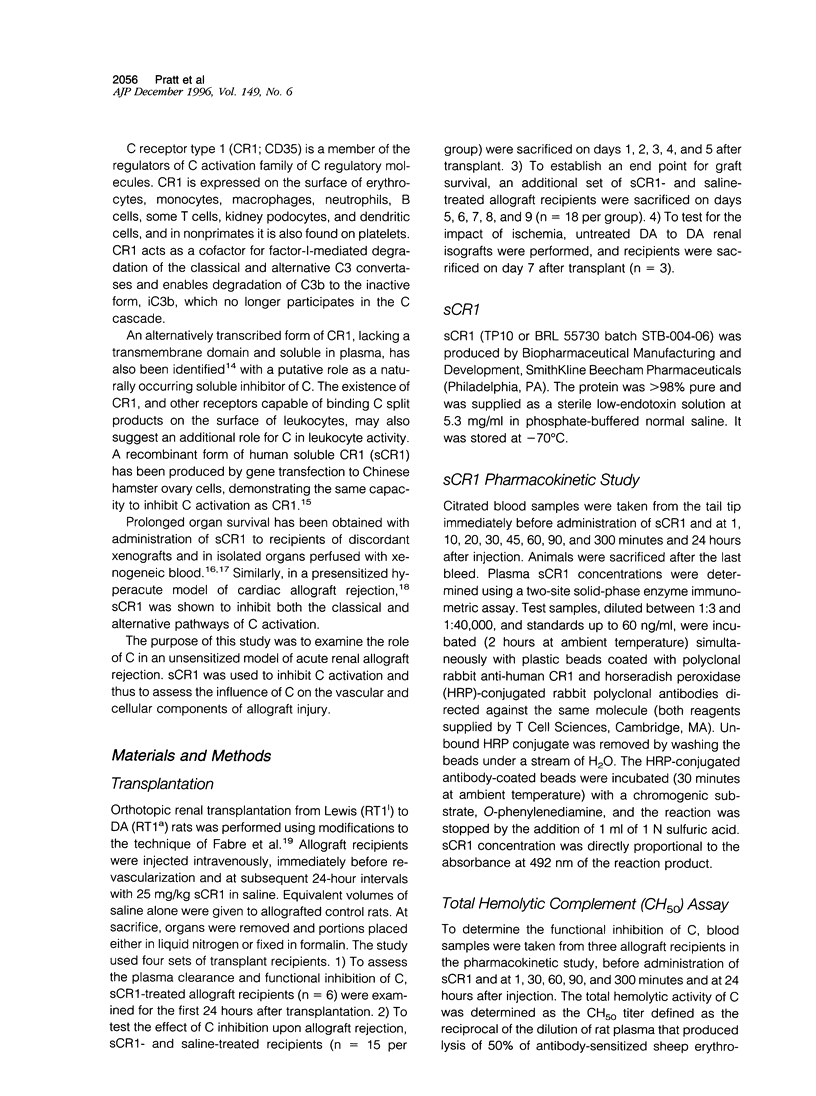
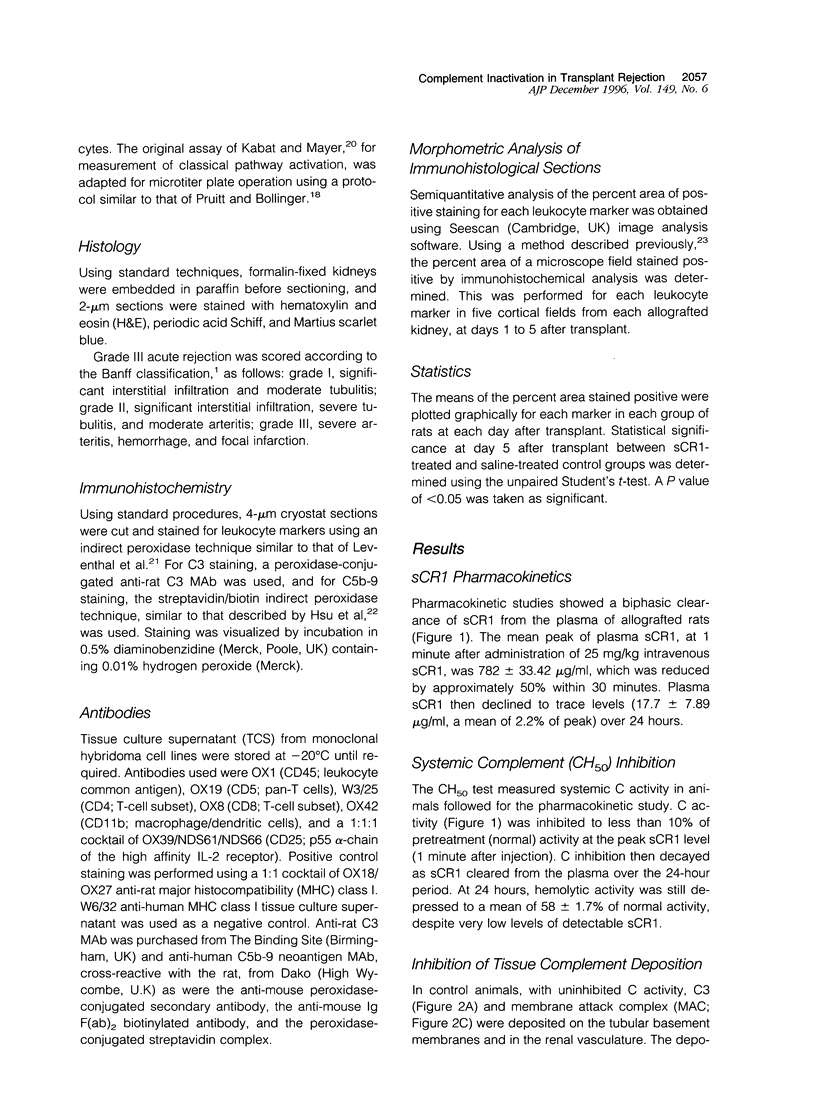

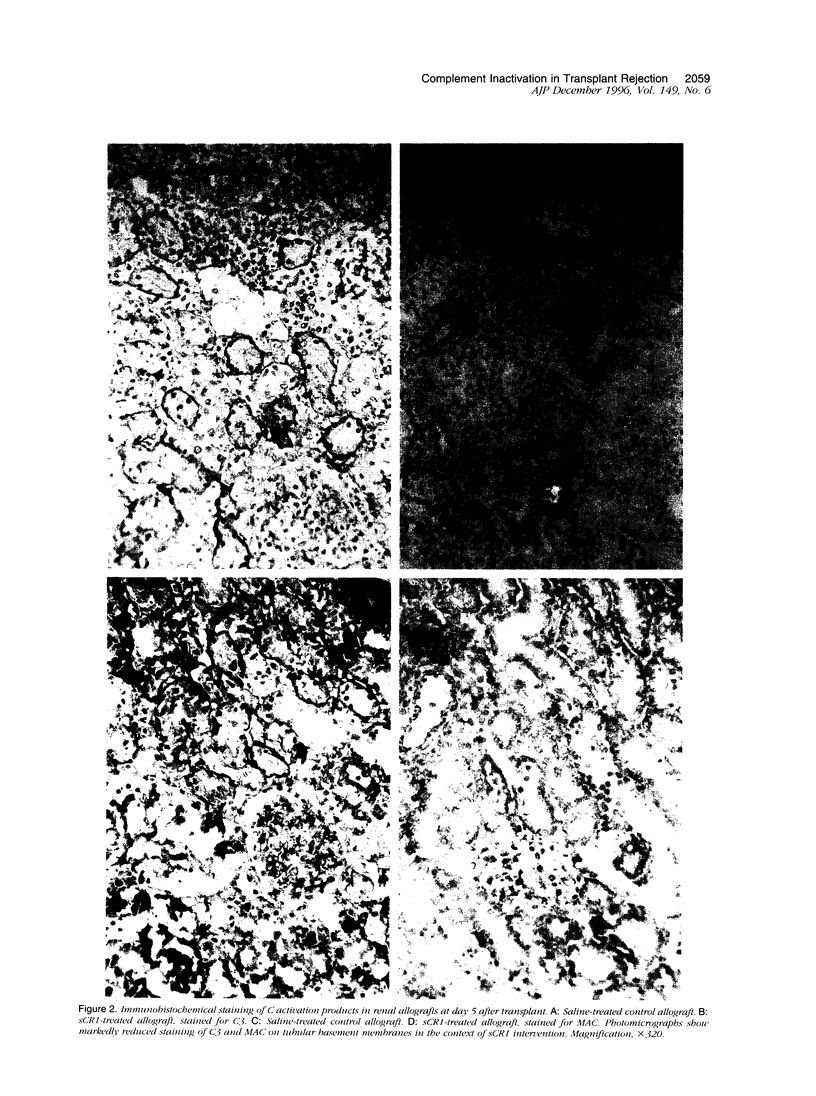
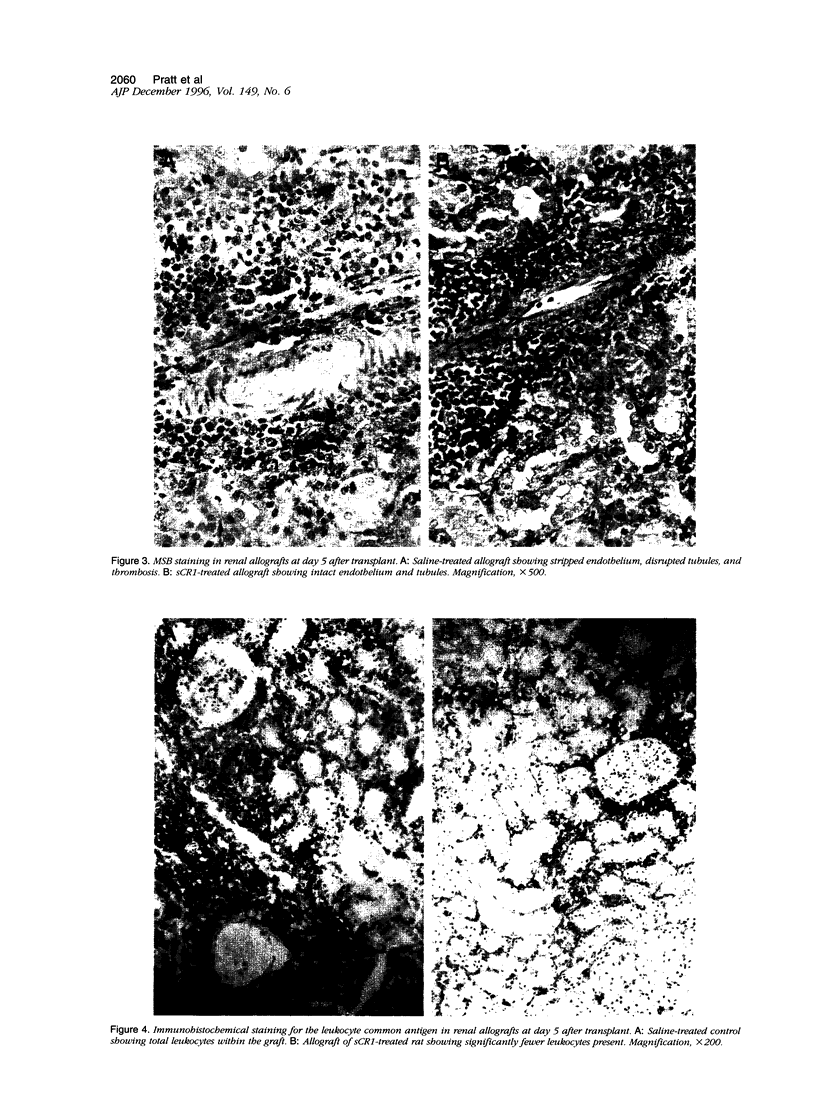

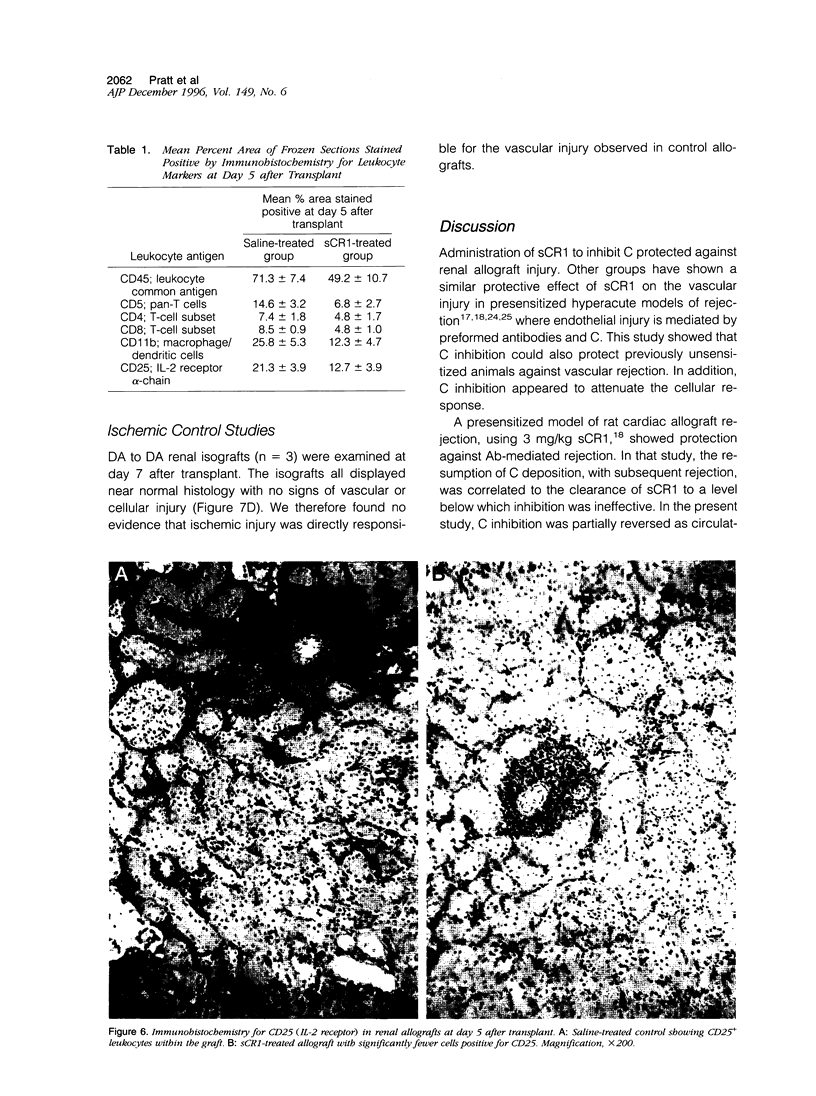
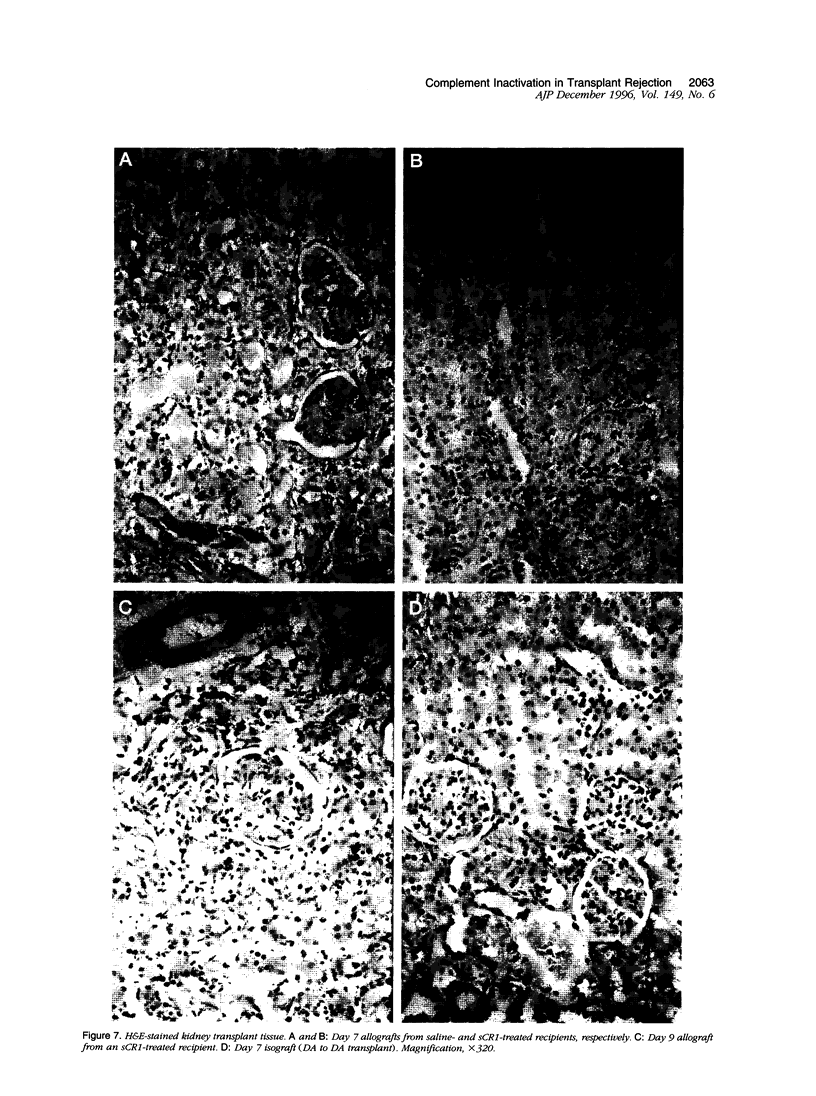
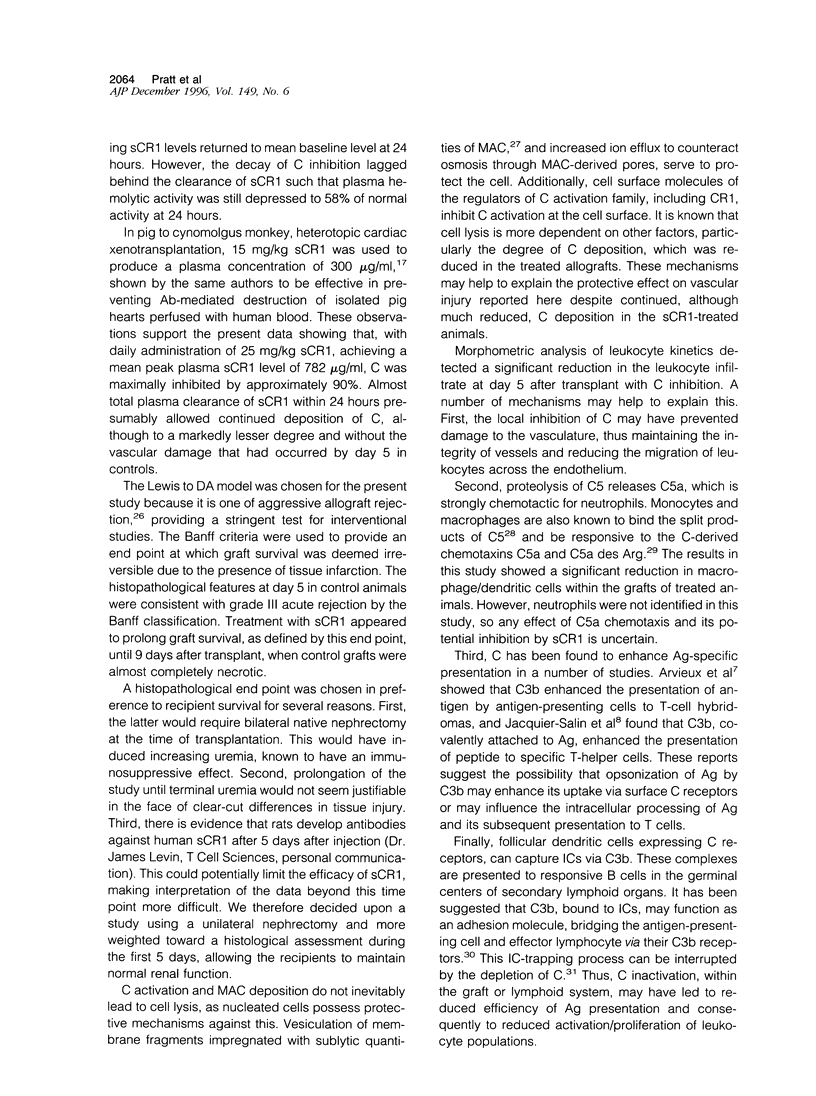
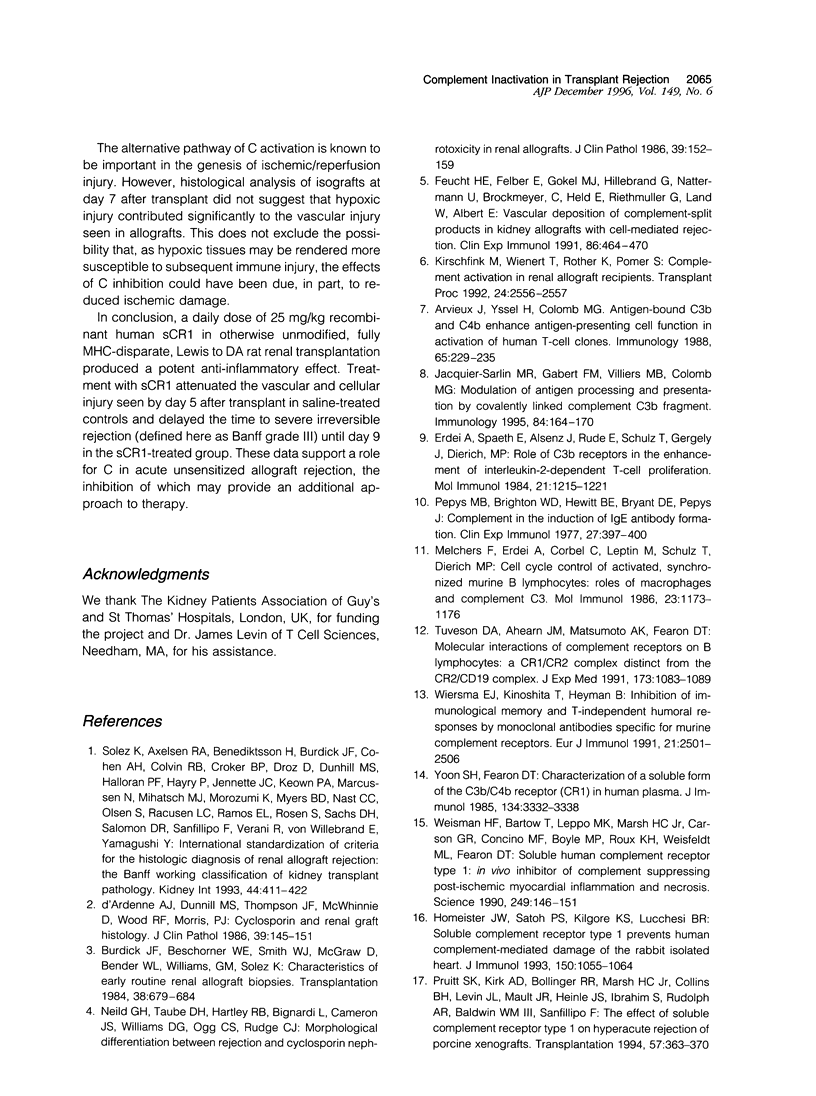
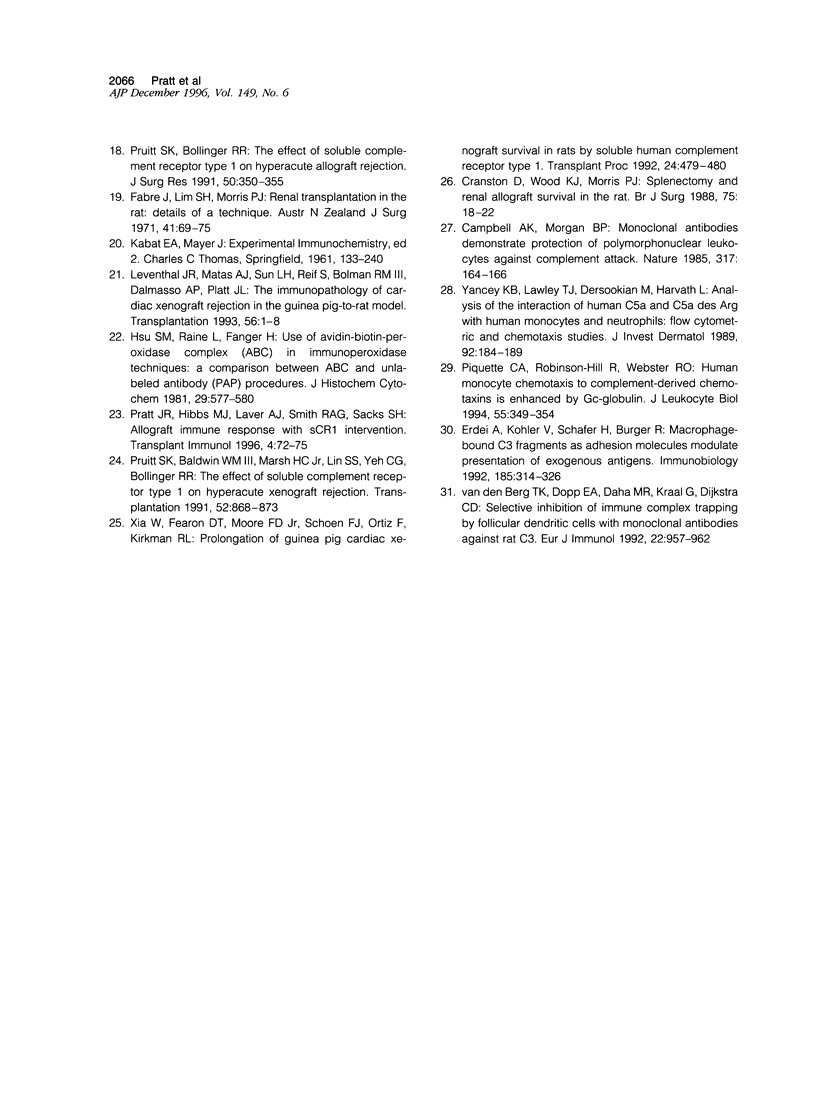
Images in this article
Selected References
These references are in PubMed. This may not be the complete list of references from this article.
- Arvieux J., Yssel H., Colomb M. G. Antigen-bound C3b and C4b enhance antigen-presenting cell function in activation of human T-cell clones. Immunology. 1988 Oct;65(2):229–235. [PMC free article] [PubMed] [Google Scholar]
- Burdick J. F., Beschorner W. E., Smith W. J., McGraw D., Bender W. L., Williams G. M., Solez K. Characteristics of early routine renal allograft biopsies. Transplantation. 1984 Dec;38(6):679–684. doi: 10.1097/00007890-198412000-00026. [DOI] [PubMed] [Google Scholar]
- Campbell A. K., Morgan B. P. Monoclonal antibodies demonstrate protection of polymorphonuclear leukocytes against complement attack. Nature. 1985 Sep 12;317(6033):164–166. doi: 10.1038/317164a0. [DOI] [PubMed] [Google Scholar]
- Cranston D., Wood K. J., Morris P. J. Splenectomy and renal allograft survival in the rat. Br J Surg. 1988 Jan;75(1):18–22. doi: 10.1002/bjs.1800750108. [DOI] [PubMed] [Google Scholar]
- Erdei A., Köhler V., Schäfer H., Burger R. Macrophage-bound C3 fragments as adhesion molecules modulate presentation of exogenous antigens. Immunobiology. 1992 Aug;185(2-4):314–326. doi: 10.1016/S0171-2985(11)80649-2. [DOI] [PubMed] [Google Scholar]
- Erdei A., Spaeth E., Alsenz J., Rüde E., Schulz T., Gergely J., Dierich M. P. Role of C3b receptors in the enhancement of interleukin-2-dependent T-cell proliferation. Mol Immunol. 1984 Dec;21(12):1215–1221. doi: 10.1016/0161-5890(84)90013-0. [DOI] [PubMed] [Google Scholar]
- Fabre J., Lim S. H., Morris P. J. Renal transplantation in the rat: details of a technique. Aust N Z J Surg. 1971 Aug;41(1):69–75. [PubMed] [Google Scholar]
- Feucht H. E., Felber E., Gokel M. J., Hillebrand G., Nattermann U., Brockmeyer C., Held E., Riethmüller G., Land W., Albert E. Vascular deposition of complement-split products in kidney allografts with cell-mediated rejection. Clin Exp Immunol. 1991 Dec;86(3):464–470. doi: 10.1111/j.1365-2249.1991.tb02954.x. [DOI] [PMC free article] [PubMed] [Google Scholar]
- Homeister J. W., Satoh P. S., Kilgore K. S., Lucchesi B. R. Soluble complement receptor type 1 prevents human complement-mediated damage of the rabbit isolated heart. J Immunol. 1993 Feb 1;150(3):1055–1064. [PubMed] [Google Scholar]
- Hsu S. M., Raine L., Fanger H. Use of avidin-biotin-peroxidase complex (ABC) in immunoperoxidase techniques: a comparison between ABC and unlabeled antibody (PAP) procedures. J Histochem Cytochem. 1981 Apr;29(4):577–580. doi: 10.1177/29.4.6166661. [DOI] [PubMed] [Google Scholar]
- Jacquier-Sarlin M. R., Gabert F. M., Villiers M. B., Colomb M. G. Modulation of antigen processing and presentation by covalently linked complement C3b fragment. Immunology. 1995 Jan;84(1):164–170. [PMC free article] [PubMed] [Google Scholar]
- Kirschfink M., Wienert T., Rother K., Pomer S. Complement activation in renal allograft recipients. Transplant Proc. 1992 Dec;24(6):2556–2557. [PubMed] [Google Scholar]
- Leventhal J. R., Matas A. J., Sun L. H., Reif S., Bolman R. M., 3rd, Dalmasso A. P., Platt J. L. The immunopathology of cardiac xenograft rejection in the guinea pig-to-rat model. Transplantation. 1993 Jul;56(1):1–8. doi: 10.1097/00007890-199307000-00001. [DOI] [PubMed] [Google Scholar]
- Melchers F., Erdei A., Corbel C., Leptin M., Schulz T., Dierich M. P. Cell cycle control of activated, synchronized murine B lymphocytes--roles of macrophages and complement C3. Mol Immunol. 1986 Nov;23(11):1173–1176. doi: 10.1016/0161-5890(86)90148-3. [DOI] [PubMed] [Google Scholar]
- Neild G. H., Taube D. H., Hartley R. B., Bignardi L., Cameron J. S., Williams D. G., Ogg C. S., Rudge C. J. Morphological differentiation between rejection and cyclosporin nephrotoxicity in renal allografts. J Clin Pathol. 1986 Feb;39(2):152–159. doi: 10.1136/jcp.39.2.152. [DOI] [PMC free article] [PubMed] [Google Scholar]
- Pepys M. B., Brighton W. D., Hewitt B. E., Bryant D. E., Pepys J. Complement in the induction of IgE antibody formation. Clin Exp Immunol. 1977 Mar;27(3):397–400. [PMC free article] [PubMed] [Google Scholar]
- Piquette C. A., Robinson-Hill R., Webster R. O. Human monocyte chemotaxis to complement-derived chemotaxins is enhanced by Gc-globulin. J Leukoc Biol. 1994 Mar;55(3):349–354. doi: 10.1002/jlb.55.3.349. [DOI] [PubMed] [Google Scholar]
- Pratt J. R., Hibbs M. J., Laver A. J., Smith R. A., Sacks S. H. Allograft immune response with sCR1 intervention. Transpl Immunol. 1996 Mar;4(1):72–75. doi: 10.1016/s0966-3274(96)80041-4. [DOI] [PubMed] [Google Scholar]
- Pruitt S. K., Baldwin W. M., 3rd, Marsh H. C., Jr, Lin S. S., Yeh C. G., Bollinger R. R. The effect of soluble complement receptor type 1 on hyperacute xenograft rejection. Transplantation. 1991 Nov;52(5):868–873. doi: 10.1097/00007890-199111000-00022. [DOI] [PubMed] [Google Scholar]
- Pruitt S. K., Bollinger R. R. The effect of soluble complement receptor type 1 on hyperacute allograft rejection. J Surg Res. 1991 Apr;50(4):350–355. doi: 10.1016/0022-4804(91)90202-w. [DOI] [PubMed] [Google Scholar]
- Pruitt S. K., Kirk A. D., Bollinger R. R., Marsh H. C., Jr, Collins B. H., Levin J. L., Mault J. R., Heinle J. S., Ibrahim S., Rudolph A. R. The effect of soluble complement receptor type 1 on hyperacute rejection of porcine xenografts. Transplantation. 1994 Feb;57(3):363–370. doi: 10.1097/00007890-199402150-00009. [DOI] [PubMed] [Google Scholar]
- Solez K., Axelsen R. A., Benediktsson H., Burdick J. F., Cohen A. H., Colvin R. B., Croker B. P., Droz D., Dunnill M. S., Halloran P. F. International standardization of criteria for the histologic diagnosis of renal allograft rejection: the Banff working classification of kidney transplant pathology. Kidney Int. 1993 Aug;44(2):411–422. doi: 10.1038/ki.1993.259. [DOI] [PubMed] [Google Scholar]
- Tuveson D. A., Ahearn J. M., Matsumoto A. K., Fearon D. T. Molecular interactions of complement receptors on B lymphocytes: a CR1/CR2 complex distinct from the CR2/CD19 complex. J Exp Med. 1991 May 1;173(5):1083–1089. doi: 10.1084/jem.173.5.1083. [DOI] [PMC free article] [PubMed] [Google Scholar]
- Van den Berg T. K., Döpp E. A., Daha M. R., Kraal G., Dijkstra C. D. Selective inhibition of immune complex trapping by follicular dendritic cells with monoclonal antibodies against rat C3. Eur J Immunol. 1992 Apr;22(4):957–962. doi: 10.1002/eji.1830220412. [DOI] [PubMed] [Google Scholar]
- Weisman H. F., Bartow T., Leppo M. K., Marsh H. C., Jr, Carson G. R., Concino M. F., Boyle M. P., Roux K. H., Weisfeldt M. L., Fearon D. T. Soluble human complement receptor type 1: in vivo inhibitor of complement suppressing post-ischemic myocardial inflammation and necrosis. Science. 1990 Jul 13;249(4965):146–151. doi: 10.1126/science.2371562. [DOI] [PubMed] [Google Scholar]
- Wiersma E. J., Kinoshita T., Heyman B. Inhibition of immunological memory and T-independent humoral responses by monoclonal antibodies specific for murine complement receptors. Eur J Immunol. 1991 Oct;21(10):2501–2506. doi: 10.1002/eji.1830211029. [DOI] [PubMed] [Google Scholar]
- Xia W., Fearon D. T., Moore F. D., Jr, Schoen F. J., Ortiz F., Kirkman R. L. Prolongation of guinea pig cardiac xenograft survival in rats by soluble human complement receptor type 1. Transplant Proc. 1992 Apr;24(2):479–480. [PubMed] [Google Scholar]
- Yancey K. B., Lawley T. J., Dersookian M., Harvath L. Analysis of the interaction of human C5a and C5a des Arg with human monocytes and neutrophils: flow cytometric and chemotaxis studies. J Invest Dermatol. 1989 Feb;92(2):184–189. doi: 10.1111/1523-1747.ep12276710. [DOI] [PubMed] [Google Scholar]
- Yoon S. H., Fearon D. T. Characterization of a soluble form of the C3b/C4b receptor (CR1) in human plasma. J Immunol. 1985 May;134(5):3332–3338. [PubMed] [Google Scholar]
- d'Ardenne A. J., Dunnill M. S., Thompson J. F., McWhinnie D., Wood R. F., Morris P. J. Cyclosporin and renal graft histology. J Clin Pathol. 1986 Feb;39(2):145–151. doi: 10.1136/jcp.39.2.145. [DOI] [PMC free article] [PubMed] [Google Scholar]







